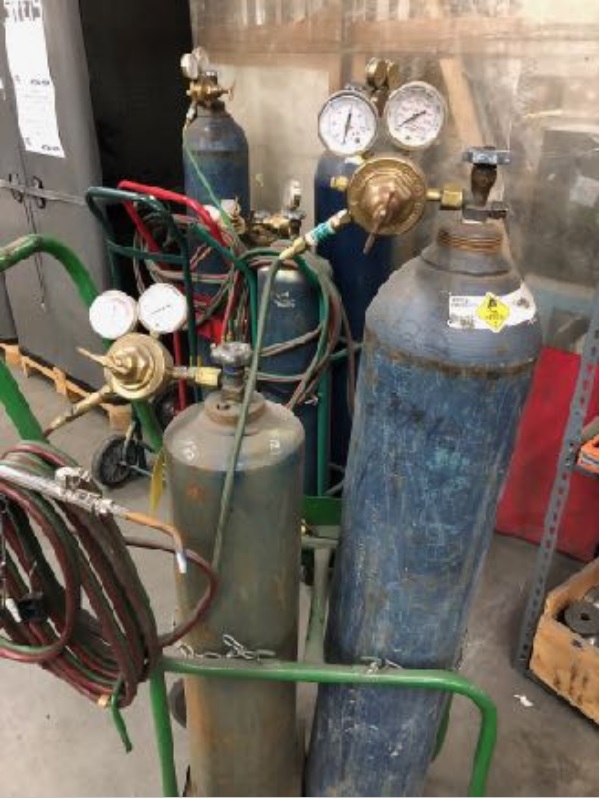Oxy-Acetylene Torches
| Extra precaution required for welders. Training / Tool Testing is essential. See Welding Safety doc. | |
|---|---|
| Eye protection required! | ||
|---|---|---|
| Oxy-Acetylene Torches | |
|---|---|
| General Info | |
| Make | Various |
| Model | n/a |
| Serial | Unknown |
| Specs | n/a |
| Manual | n/a |
| Asylum Info | |
| Location | Metal Shop |
| Rubric | n/a |
| Training | Tool classes |
| Testing | Tool testing, or come to the shop on Tool Testing Night |
| Restrictions | red |
Use for:
- Heating or cutting metal, especially carbon steel.
- Brazing
- Welding (Arc may be preferable)
Do Not Use for
- Anything that might explode when heated.
- Anything that produces excessively noxious gases when heated or burned including:
- Galvanized
- Plated
- Painted
- Oiled
- Powder-coated
Hazards
- Eye damage from looking at the flame for extended periods. Shade 3 eye protection required.
- Poisoning from gases produced when heating or vaporizing certain metals. Respirator required when appropriate.
- Injury or death from explosion due to tool misuse.
- Burns from flame, sparks, or hot workpieces.
- Two highly dangerous situations to watch for. 'Immediately shut down Acetylene torch if either occurs:
1. Pop sound. This is flashback. 2. Purple flame. Burning Acetone from tank.
Brief Safety Notes
To avoid serious injury or death, be fully aware of how the tanks, regulators, and torches work in conjunction. Follow safe operating proceedures. For more safety information, see the document:Oxy-Acetylene Safety.
Beware of Flashback an explosive situation in which Oxygen flows into the Acetylene hose. A pop sound indicates flashback. The equipment has flashback arrestors to keep the flame from backing into the tank. Still, beware.
Never use all the Acetylene in the tank. Tank Acetylene (Short Tank, Red Hose) is mixed with acetone to stabilize it under pressure. If you drain all the Acetylene, acetone will enter the torch to create and explosive situation. Note that Acetone burns purple.
Oxygen under pressure will ignite sawdust and grease. Tank Oxygen (Tall Tank, Green Hose) is under very high pressure. Oil on clothing or hands can combust under pure oxygen.
Avoid standing in front of the regulator especially when opening the cylinder valve. The weakest part of the regulator is the “bonnet,” which tends to be the first to go if the regulator explodes. The adjustment screw will shoot out with the speed of a bullet.
Keep work area free of flammable or explosive materials especially paper, oil or grease, and flammable solvents such as acetone.
Always store tanks upright never use a tank that has been stored on its side – acetone is heavier than Acetylene and will be released during use and will enter the hose. Acetone burns purple.
If cutting, cut only one sheet at a time. Steel only. No stainless, no high carbon. Consider using a plasma cutter.
Basic Operation Instructions
1. Before operation, perform a safety check on the equipment. Was it properly shut down? Were the gas cylinders stored properly?
- Are both cylinders chained up for safety?
- Are both cylinder valves closed?
- Are both regulators screws loose?
- Do all four regulator gauges read zero?
- Are all torch valves closed?
- If the answer is “NO” to any of the above complete the full shut-down procedure below. Be sure to purge the lines. Don’t take shortcuts or skip steps.
2. If needed, connect the torch head appropriate to your operation: cutting head, welding tip, or heating tip. The shop provides several tip sizes.
3. Set Acetylene working pressure. (Short Tank, Red Line)
- Open the Acetylene cylinder valve just enough to allow gas to flow. In case of emergency, closing this valve should take an instant.
- Open Acetylene torch valve about 1/2 a turn.
- Turn the Acetylene regulator screw CLOCKWISE and use the Acetylene regulator gauge to set the pressure. (5 psi is a good beginning pressure.)
- Close Acetylene torch valve.
NEVER open an Acetylene cylinder valve more than 1.5 turns.
| **Never set the Acetylene pressure higher than 15 psi.** It can explode! | |
|---|---|
